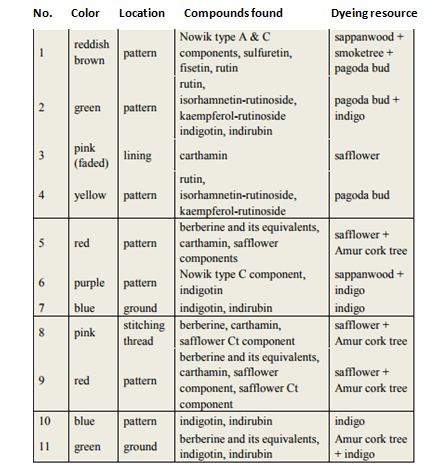Difference between revisions of "V&A T.187-1948, Woman's robe of weft-pattern woven silk, China (early 18th century)"
| Line 15: | Line 15: | ||
== References == | == References == | ||
| − | [1] https://collections.vam.ac.uk/item/ | + | [1] https://collections.vam.ac.uk/item/O73570/robe-unknown/ |
[2] Jing Han, The Historical and chemical investigation of dyes in high status Chinese costume and textiles of the Ming and Qing Dynasties (1368-1911) PhD thesis, University of Glasgow February 2016. | [2] Jing Han, The Historical and chemical investigation of dyes in high status Chinese costume and textiles of the Ming and Qing Dynasties (1368-1911) PhD thesis, University of Glasgow February 2016. | ||
Revision as of 14:19, 7 August 2017
Artifact Information
A women's woven silk with supplementary weft patterning robe (with design of sky, earth and water, 9 large five-clawed dragons pursuing and clasping the sacred discs among clouds in green, blue, red, yellow and brown silks and gold thread, Lined with pink figured silk) is unlike the other Chinese women's garments in the Museum, but the curators and conservators of V&A museum knew from 18th-century pictorial sources that it was very fashionable at the time. It is front-fastening, whereas many other robes fasten to one side. Its decoration was undertaken on the loom as weaving techniques advanced, rather than being added later in the form of embroidery. The particular layout of the dragon motifs also marks it out from other garments in the V&A's collection [1].
Victoria and Albert Museum, London, UK T.187-1948
Summary of results
Traditionally used Chinese dyes, pagoda tree buds, turmeric and safflower had been identified as the dyeing sources of this Chinese woman's robe [2]. Berberine was found in sample 2, a green thread from the pattern. Quite a few plants can generate berberine as a yellow dye [3]. The most widely used were Phellodenrom spices, for exampleAmer cork tree and Chuan Huang Bo (Huangbo from Sichuan).
References
[1] https://collections.vam.ac.uk/item/O73570/robe-unknown/
[2] Jing Han, The Historical and chemical investigation of dyes in high status Chinese costume and textiles of the Ming and Qing Dynasties (1368-1911) PhD thesis, University of Glasgow February 2016.

